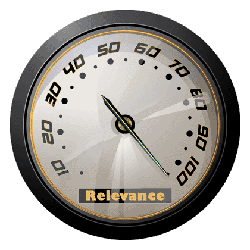 Peg the Needle on the Relevance Meter If You Want to See Results
Peg the Needle on the Relevance Meter If You Want to See Results
By Roy H. Williams
 Ads are often written under the assumption that we can get people to care about things they don’t really care about. But this approach rarely succeeds.
Ads are often written under the assumption that we can get people to care about things they don’t really care about. But this approach rarely succeeds.
Traditional ad-think says:
Target the right people
Leverage the right media (visual media for visual products, etc.)
Use creativity in delivering your message.
But nontraditional ad-think gets far better results:
1. What you say matters most of all. Speak to a felt need. Good advertising isn’t about the product or the company that sells it. Good ads explain how the customer’s life will be different.
EXAMPLE: Don’t say, “Dr. Bill Dipweasel was voted gentlest dentist in Saginaw County.”
Say, “Get your teeth fixed. You’ll be more attractive and your confidence will skyrocket. People will treat you differently.”
2. How you say it is critical. Clarity is more important than creativity. Talk like people. People don’t say, “I’ve elected to have cosmetic dentistry.” They say, “I’ve decided to get my teeth fixed.” (Dr. Bill Dipweasel will give you push-back on this because he doesn’t think “get your teeth fixed” sounds professional. Also, he wants the ad to be about him.)
3. Deliver your message using whatever media offers the best psychological environment. In what moments would a candidate for cosmetic dentistry be most open to the message we crafted about being treated differently?
Advertising works best when it speaks to what customers already care about. This is called “speaking to a felt need.” I’ve never met anyone that’s had a secret, unmet desire to go to the dentist. But tens of millions of us secretly wish we were more attractive, more confident, and that people treated us differently. Capiche?
Good ads aren’t about the company that’s paying for the ad. Good ads are about the reader, the listener, the viewer of the ad. This is especially true when writing classified ads for employment.
A man attending a class at Wizard Academy confessed that, working part time, he had made more than $850,000 in employee placement fees as the direct result of a single chapter he had read in my second book. I congratulated him on having had the perception to recognize the potential in that chapter.
Last week I received an email about that same chapter in my second book from William, an Acadgrad living in St. Petersburg, Russia.
Dear Roy,
I received an email from my business partner (Thatcher) earlier today, telling me that we had found the perfect applicant for an opening we have in our company. I crafted the job ad based on one of your chapters in the second Wizard of Ads book.
This is what I replied to him: “She’s perfect. The Wizard of Ads is a genius, and this girl is just what we want, don’t you think? I mention the Wizard because I used an article of his on writing job ads for that one. He said the person we were looking for would recognise themselves in the ad, and we wouldn’t be swamped with tedious junky mass-applications. And indeed that’s what happened.”
So thank you, Roy, for all your amazing free advice; I have yet to meet this girl, but judging by the application, I think she should fit in well.
Eternally gratefully yours,
William
That chapter, by the way, is called “Writing Classified Ads for Employment.” It’s chapter 76 in a 101-chapter book called Secret Formulas of the Wizard of Ads, a New York Times and Wall Street Journal bestseller.
William, I’m glad you found the perfect employee. I look forward to your next visit to Austin.
♦
